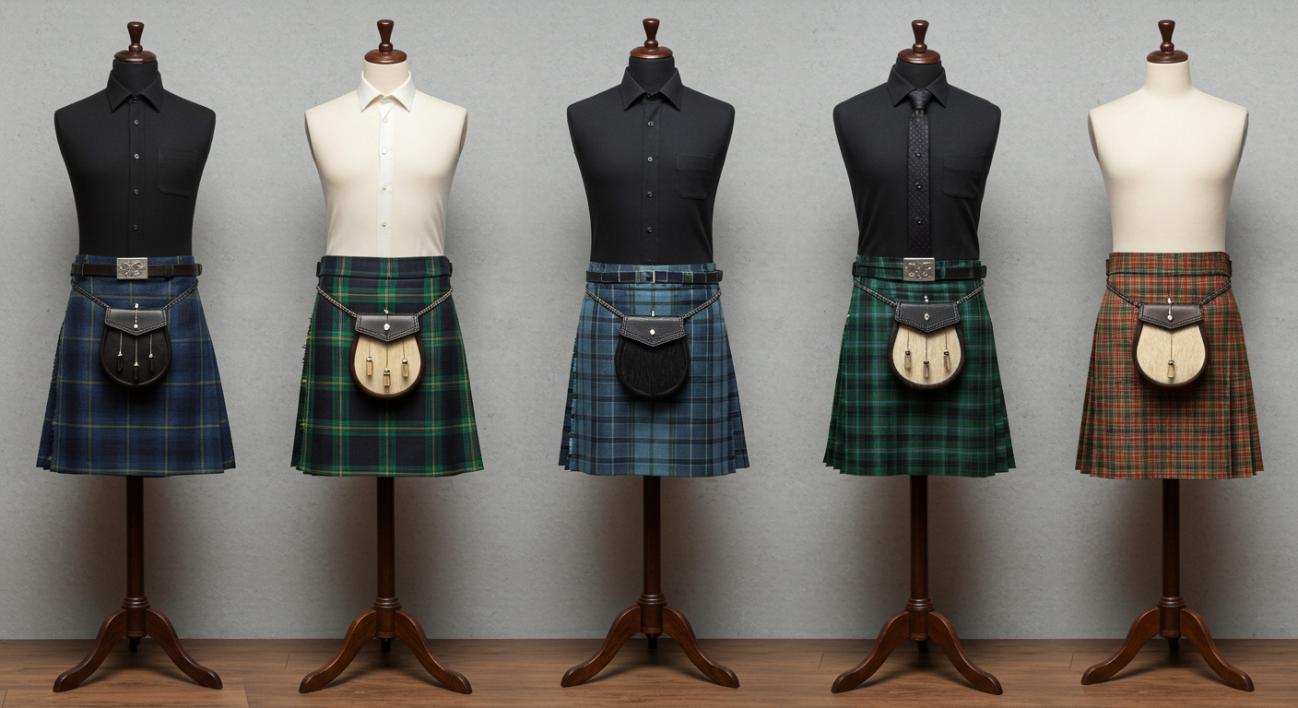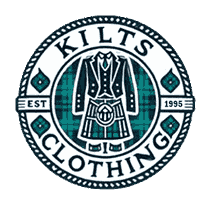How to Choose the Perfect Irish Kilt for Your Body Type

The Irish kilt is a garment rich in tradition, deeply rooted in Irish culture and beloved worldwide for its unique style. Whether you're preparing for a formal event or a casual gathering or want to embrace your heritage, choosing the proper kilt is essential for both comfort and appearance. But, with various cuts, fabrics, and pleating options available, how do you know which Irish kilt is perfect for your body type? The right fit can make all the difference, not only in how the kilt feels but also in how you look while wearing it.
In this blog, we'll guide you through selecting the perfect Irish kilt based on your body shape, ensuring you feel both comfortable and confident. Let's get started!
1. Understanding the Different Styles of Irish Kilts
Before diving into the specifics of body types, it's essential to know the basic styles and options available when choosing a kilt. Artisans make the traditional Irish kilt from wool, using various tartan patterns to represent different Irish clans or regions. However, modern variations are available in a range of fabrics, such as cotton, denim, and even synthetic blends.
Key elements to consider include:
- Pleating style: The way the kilt is pleated can affect how it fits and moves. Common styles include knife pleats, box pleats, and accordion pleats.
- Waistband: Kilts typically feature either a traditional leather strap waistband or a modern, adjustable fabric waistband.
- Length: Traditional kilts usually reach just above the knee, but some modern styles may vary in length.
Each of these elements suits your body type and personal style.
2. The Importance of Fit: Why Size and Shape Matter
A well-fitted kilt is not just about looking good—it's about feeling comfortable, too. An ill-fitting kilt can restrict movement, be uncomfortable, and compromise your overall look. A kilt that's too tight or too loose can affect the balance of your silhouette, especially when considering the pleats and the fabric's flow.
When selecting an irish tartan kilt, it's essential to understand your body shape so you can choose one that flatters your proportions. A well-chosen kilt will highlight your best features and create a balanced, harmonious look.
3. How to Determine Your Body Type
To help you choose the ideal kilt, it's crucial first to understand your body type. Here are the key body shapes and how to select the best women and mens irish kilt for each:
Hourglass Shape
A defined waist with balanced hips and shoulders characterizes an hourglass figure. If this sounds like you, congratulations—an hourglass shape is considered one of the easiest to fit with an Irish kilt.
- Kilt Fit Tip: Opt for a kilt that sits comfortably on your natural waistline. Pleats should not be too voluminous or too narrow. A moderate pleat size works well to maintain the balance of your proportions.
Rectangle Shape
A rectangular body shape is more straight up and down, with little definition between the waist and hips. The goal with this body type is to create the illusion of curves.
- Kilt Fit Tip: Choose a kilt with more fullness in the pleats to add volume and create a more hourglass-like appearance. A slightly higher waistband can also add definition to the waist.
Triangle Shape (Pear Shape)
For those with a pear-shaped body, the hips are wider than the shoulders, and the waist is narrower—this body type benefits from drawing attention upward and balancing out the lower half.
- Kilt Fit Tip: Opt for kilts with deeper pleats to add volume to the lower half. Look for kilts made from lightweight fabrics, which won't add unnecessary bulk to the hips and thighs.
Inverted Triangle Shape
Broad shoulders and a narrower waist and hips characterize inverted triangle shapes. The goal is to balance the top-heavy look by drawing attention to the lower half of the body.
- Kilt Fit Tip: Choose kilts with less pleating or subtle pleats that help streamline the lower half. A simple, straight fit will help balance out broad shoulders. Avoid overly stiff fabrics that add bulk to the upper body.
Apple Shape
An apple-shaped body has a broader midsection with slimmer hips and legs. The key here is to create a proportionate look and focus on elongating the torso.
- Kilt Fit Tip: A mid-rise or high-waisted kilt works best, as it helps control the midsection and gives a more defined shape. Go for a kilt with a looser fit around the waist to avoid drawing attention to this area.
4. Key Considerations for Each Body Type When Choosing a Kilt
Now that we've outlined the body types, here's a more detailed look at what to keep in mind when selecting a kilt for each body type:
- Hourglass: Choose a kilt with a moderate pleat size and a waistband that fits your natural waist. A mid-length kilt that ends just above the knee is ideal for this body type.
- Rectangle: Select a kilt with more fullness in the pleats to add shape to the hips. A kilt with a slightly higher waistband or a pleated back can also create a more feminine curve.
- Triangle (Pear): Look for kilts with deeper pleats or a bit of extra fullness in the lower half. A kilt with a simple, slightly higher waistband will draw attention upward and balance your proportions.
- Inverted Triangle: Opt for kilts that are not too voluminous in the pleats. A pleat that's closer to the back rather than the sides can create a more streamlined silhouette.
- Apple Shape: A mid-to-high-rise kilt works best, as it sits comfortably on the waist without drawing attention to the midsection. Look for kilts that fall to just above the knee for a more balanced look.
5. Waistband Choices: How to Find the Most Comfortable Fit
The waistband plays a crucial role in how a kilt fits and feels. It should sit comfortably around your waist without cutting into your skin or being too loose. Traditional Irish kilts typically feature a leather strap or buckle that allows for an adjustable fit. At the same time, modern designs may include a fabric waistband with more flexibility.
- Tip: When purchasing a kilt, ensure you measure your waist accurately. It's always better to have a kilt that's a bit too loose than one that's too tight, as it's easier to adjust the fit later.
6. Length Matters: Finding the Right Kilt Length for Your Height
The length of your kilt is another critical consideration. Traditional Irish kilts are usually knee-length, but depending on your height, you may want to adjust this.
- Taller Individuals: If you're taller, opt for a slightly longer kilt. A longer kilt will prevent the hem from rising too high above the knee and will maintain the proportion of your body.
- Shorter Individuals: For those who are shorter, a slightly shorter kilt can help elongate the legs. Avoid kilts that are too long, as they may make your legs appear shorter.
7. Pleats and Fabric: How to Choose the Right Fit for Your Body Type
The pleats in your kilt can affect the way it fits and how it flatters your body shape. For example, larger pleats can add volume, making them ideal for those with slimmer builds. In contrast, more subtle pleats will help balance out broader figures.
Additionally, fabric choice is essential. Heavier wool fabrics work well for more muscular or fuller body types. In comparison, lighter fabrics like cotton or synthetic blends are better for more slender individuals.
8. Custom vs. Off-the-Rack Kilts: When to Choose Tailored Fit
While off-the-rack kilts can work well for many people, those who are looking for the perfect fit may want to consider a custom-made kilt. A tailored kilt will ensure a precise fit, especially if you have unique body measurements or specific style preferences. A custom kilt can also give you more control over fabric choices, pleating style, and waistbands.
9. Conclusion:
Choosing the proper Irish kilt for your body type is about more than just appearance—it's about feeling comfortable and confident in what you wear. Understanding your body shape and considering factors like pleating style, waistband fit, and fabric choice will help you find the perfect kilt. Whether you're wearing it for a special occasion or as part of your everyday style, a well-fitted kilt is a celebration of Irish tradition and your identity.
Take your time, try on different styles, and most importantly, wear your Irish kilt with pride.


